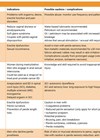Timing is everything.’ Although an expression most frequently linked to comedy, timing also seems just as critical in the business of sexual climax. Indeed, many men worry about ejaculating. Too soon is embarrassing. Too slow is frustrating. And not ejaculating at all is plain distressing. Yet when does the perception of an ejaculatory problem become a true clinical pathology? How should we address the significant anxiety attributed to ejaculation? And most importantly, how can we as urologists assess and manage those who do present for help?
Male sexual dysfunction encompasses both erectile dysfunction and ejaculatory dysfunction, the latter being comparatively under recognised and under treated. Ejaculatory dysfunction describes a spectrum of symptoms ranging from premature ejaculation to delayed or absent ejaculation (anejaculation) and retrograde ejaculation whereby the semen goes backwards into the bladder.
Pathophysiology of ejaculation
Ejaculation has two main phases, emission and expulsion. This response is a complex, highly orchestrated phenomenon. Emission entails the formation of semen from sperm and seminal fluid in the posterior urethra. Integral structures include the epididymis, the vas deferens, the seminal vesicles, the prostate gland and the posterior urethra. This is controlled by sympathetic innervation from T10-L2. Expulsion consists of coordinated pelvic and penile muscular contractions resulting in propulsion of the semen through the urethra. This is controlled at the lower level of S2-4 by somatic innervation, with both sympathetic, somatic and sensory neural inputs. Ejaculation thus forms the culmination of the male sexual response, in which desire, arousal, orgasm and resolution occur; involving the secretion of spermatozoa and seminal fluid into the prostatic urethra, followed by forceful rhythmical expulsion. It should also be noted that while often occurring concurrently, orgasm does not necessitate ejaculation, and vice versa.
Too swift
Premature ejaculation (PE) is the most well-known ejaculatory dysfunction [1]. Estimating the prevalence is problematic for several reasons. Firstly, a clear concise definition as to what constitutes PE has been lacking. Secondly, due to such low numbers of men who feel comfortable seeking medical advice, the consensus is that the vast majority simply remain under the radar of healthcare professionals. Unfortunately, there is a global misconception that there is no treatment for PE, which is often stated as the main reason men fail to seek help. Consequently, this is a poorly studied cohort.
What we do know, is that the documented prevalence of PE seems to vary between countries and amongst different ethnic groups. For example, the prevalence of PE in Asian countries and ethnicities tends to be higher, while the prevalence in Europe tends to be lower [2]. This may of course be due to cultural differences and varying attitudes and beliefs towards sex.
Definition
Definitions of PE have been drafted and revised by various consensus committees and professional organisations over the past 20 years. The absence of a standardised definition has limited high quality research.
An updated definition from the International Society of Sexual Medicine (comprising a committee of internationally recognised experts who were tasked to remove the ambiguity of previous work in the field) has been adopted, which is contingent on the following characteristics [3]:
- Ejaculation that always or nearly always occurs prior to or within about one minute of vaginal penetration (lifelong PE).
- A clinically significant and bothersome reduction in latency time, often to about three minutes or less (acquired PE).
- Inability to delay ejaculation on all or nearly all vaginal penetrations (loss of control).
- Negative personal consequences, such as distress, bother, frustration and / or the avoidance of sexual intimacy.
Interestingly, there is frequent reference to vaginal penetration in all definitions of premature ejaculation. Therefore, a diagnosis at present is contingent on vaginal penetration as a means of sexual intimacy, with oral, anal or masturbatory latencies unclear. Detailed history taking, despite this often being a difficult topic to explore in clinic, is essential. Furthermore, in a culture saturated with sexualised content, from film to TV to porn, some have suggested there is a widespread misunderstanding of what is ‘normal’ with regards to latency in real world sexual encounters. Overall, anxiety may play a causal or perpetuating role.
Some men who present to clinic may subjectively feel distressed about ejaculatory function, but do not meet the diagnostic criterion of PE. These cases are nominally described as ‘variable PE’ whereby short ejaculatory latency occurs but irregularly and inconsistently. This is not a sexual dysfunction but a normal variation in sexual performance. These men benefit from reassurance and counselling as opposed to medical treatment.
Aetiology
The aetiology of PE has never been confirmed in large studies, but many factors have been proposed. It has been argued that PE is caused by psychological factors, unresolved unconscious conflicts, relationship problems, and / or self-learned behaviour. On the other hand, a role is also seen for somatic factors, like hypersensitivity of the glans penis or a higher cortical representation of the pudendal nerve. Multiple aetiological factors, likely including disturbances in the central serotonergic neurotransmission and serotonergic receptor functioning, make it a complex area to fully understand [4]. Furthermore, most of our current understanding of the neurobiology of sexual behaviour and ejaculatory function has been derived from animal studies using rats with normal sexual behaviour.
The role of serotonin
Serotonin is the main neurotransmitter controlling ejaculation. To date, three serotonin-receptor subtypes (5-HT1A, 5-HT1B, and 5-HT2C) have been implicated in mediating 5-HT’s inhibiting activity on ejaculation [5]. Furthermore, PE can be treated effectively by selective serotonin reuptake inhibitors (SSRIs) although their mechanism of action is not yet well understood. In particular, it is not clear why all SSRIs are not equal in terms of their ability to delay ejaculation.
Diagnostic evaluation
A medical and sexual history is required, with key questions needed to establish whether there is lifelong PE or acquired PE. Understanding whether PE is limited to a certain partner or specific situations is also helpful.
Diagnostic doubt can occur when there is overlap between erectile dysfunction (ED) and PE. A man who is struggling to gain and maintain an erection, may therefore hastily penetrate and ejaculate quickly: the underlying issue here is ED. Conversely, a man with PE may struggle to gain a second erection after rapid ejaculation, yet complain of ED. Here however, the issue is actually PE.
Patients may not readily volunteer information in clinic, so open and direct questioning will help to elicit a full sexual history.
Recommended questions:
- What is the time delay between penetration and ejaculation?
- Can you delay ejaculation?
- Do you feel annoyed / frustrated by this?
If PE is suspected, this can be followed by:
- When did you first experience this (every attempt with every partner vs. more recent)?
- How would you describe the quality of your erection – is it always hard enough to penetrate?
- How upset is your partner with the premature ejaculation?
As well as a thorough history and examination, various novel diagnostic and assessment methods have been suggested. However, a 2020 review concluded there remains a “lack of feasible and plausible means of objective measurement” of ejaculatory latency and control [6].
Treatment
Behavioural techniques
Psychosexual therapy for men or couples troubled with PE aims to help develop skills to facilitate a delay in ejaculation whilst simultaneously increasing confidence and reducing performance anxiety. Examples include the ‘start stop technique’ or the ‘squeezing technique’. With these, men recognise when they are moderately excited and try to limit stimulation to increase the intravaginal ejaculatory latency time (IELT).
In some tertiary centres, a dedicated psychosexual councillor may be available, but awareness of these behavioural exercises is important. In the ‘start stop’ method, the partner stimulates the penis until there is an urge to ejaculate, at which point contact abruptly stops until the sensation passes. The ‘squeezing’ method is similar but involves the application of manual pressure to the glans just prior to ejaculation, until the man loses the urge. These cycles are repeated multiple times before the man progresses to climax [2].
Drug treatment
Pharmacological treatment historically consisted of topical local anaesthetic to decrease the sensitivity of the glans penis, but the treatment of PE was revolutionised by the use of SSRIs which inhibit serotonin uptake from the synaptic cleft. On demand SSRIs, such as dapoxetine (the only drug licenced) or off label sertraline, fluoxetine or citalopram, are well established treatments [5].
Dapoxetine (Priligy®) was launched in the UK in November 2013 for the treatment of premature ejaculation in adult men aged 18-64 years. It should only be prescribed to men who meet all the following criteria [7]:
- An intravaginal ejaculatory latency time of less than two minutes;
- Persistent or recurrent ejaculation with minimal sexual stimulation before, on, or shortly after penetration and before the man wishes;
- Marked personal distress or interpersonal difficulty as a consequence of premature ejaculation;
- Poor control over ejaculation;
- A history of premature ejaculation in the majority of intercourse attempts over the prior six months.
Typically, the starting dose is 30mg, taken one to three hours prior to sexual activity. This can be increased to 60mg if there is insufficient response. Other longer-acting SSRIs (e.g. citalopram, fluoxetine and paroxetine) have a longer onset of action so need to be taken on a daily basis and cannot be used as ‘on-demand’ treatments.
Too slow
At the other extreme, delayed ejaculation (DE) is defined by the inability of a man to ejaculate in a reasonable period of time with normal sexual stimulation, the most severe form being anejaculation (AE). While a recognised occurrence, aetiology is complex, may often be multifactorial, and remains poorly understood. Estimated prevalence is only 1-4% of the male population [8]. This picture can be further complicated as men with DE may struggle with both ejaculation and orgasm [9].
Definition and diagnosis
DE is characterised by a marked delay, marked infrequency or absence of ejaculation on 75-100% of occasions for ≥ six months of partnered sexual activity without the individual desiring delay, and causing significant distress to the individual [10]. The most recent International Consultation on Sexual Medicine quantified this as an IELT beyond 20-25 minutes as well as personal distress caused by this [11].
However, this classification has been criticised by some, with Perelman et al. suggesting DE should be defined as a) inability / incapacity to choose to ejaculate intravaginally in less than approximately 10 minutes in all, or nearly all, coital encounters; b) not having the ability / capacity to choose to ejaculate sooner, but desiring the ability to do so; and c) experiencing negative personal consequences, such as distress, bother, frustration, and / or the avoidance of sexual intimacy [12].
Aetiology
Multiple aetiological factors can be involved in DE / AE. These include psychosexual / psychosocial factors as well as organic and biological factors – such as ageing, diabetic neuropathy, surgical sequelae, infections, endocrine dysfunction and medications [9]. A 2003 study also suggests that there is a correlation between ejaculatory dysfunction and both increasing age and severity of prostatic hyperplasia / lower urinary tract symptoms [13]. Treatment Treatment can broadly be divided into psychological and pharmacological, yet both have a relatively sparse evidence base. Psychological management may include psychotherapy or sexual therapy. While there are no drugs licenced for DE / AE, several have been trialled, albeit in small numbers. These have included cabergoline (a dopamine-2 and 5-HT2B receptor agonist), alpha-adrenergic agonists and atypical antidepressants.
However, there remains a paucity in high quality evidence for any of these treatments [14]. Benign prostatic hyperplasia (BPH) causing lower urinary tract symptoms may contribute to DE. Nevertheless, the first-line treatment for this (alpha-blockers such as tamsulosin) can also cause retrograde ejaculation and anejaculation, now postulated to be due to a centrally mediated process. There is therefore a trade off between one disorder of ejaculation for another [1,15]. Furthermore, surgical treatment for prostatic hyperplasia is often linked with ejaculatory dysfunction afterwards, and this is important to discuss in the consent process.
The no show
The final category of ejaculatory dysfunction encompasses two symptomatically identical phenomenon. Anejaculation (AE) is the complete absence of an antegrade or retrograde ejaculation (RE). However, RE may be experienced as anejaculation. Normal orgasmic sensation is usually preserved.
Definition and diagnosis
Key areas to explore include any reduction in ejaculate over time, or cloudy urine post-orgasm – both of which may suggest retrograde passage of semen into the bladder. Other important factors are medication history, nervous system dysfunction and any past surgical history.
Aetiology
RE occurs when the semen is directed back towards the bladder from the posterior urethra, rather than being propelled forwards to the urethral meatus. Typically, this is caused by intrinsic problems with the internal bladder sphincter, which may be neurological or iatrogenic (secondary to surgical intervention or medication). True anejaculation is typically connected with a central or peripheral nervous system dysfunction.
Neurological causes of RE include spinal cord injury and diabetic neuropathy compromising the sympathetic innervation to the bladder neck. Reduced contraction in turn prevents the normal blockade to sperm progressing retrograde in the urethra (up to 30% of diabetics are thought to suffer from RE [16]). Through similar mechanisms, drugs resulting in sympathetic antagonism are also implicated in RE, including alpha blockers (tamsulosin) antipsychotics and ganglion blockers.
Another common cause of retrograde ejaculation is iatrogenic postoperatively. It is a well-recognised complication of many prostate surgeries – including prostatectomy and bladder outlet obstruction procedures. Other operations which can disrupt normal functioning are those which may disrupt the neurological pathways, for example lymph node clearance and colorectal procedures.
Treatment
The key question prior to considering treatment in RE is whether or not the patient wants to have children in the future. Those who do not, may not need over investigation or require treatment [17]. Conversely, in those wishing to have children, active treatment will be necessitated, and can range from pharmacological to surgical. Post orgasmic urine samples can also be sent, looking for sperm to confirm the diagnosis. As with other ejaculatory dysfunction, there remains only a small body of literature to support these different treatment options [18].
Pharmacological treatments for RE include sympathetic alpha-1-receptor agonists (which promote bladder neck closure and seminal vesicle / vas deferens contraction via sympathetics) and tricyclic antidepressants (which are sympathomimetic via adrenaline reuptake inhibition causing bladder neck contraction). The former are typically taken on-demand due to the potential side-effects, whereas the tricyclics are often taken daily with the option of on-demand doses where required.
Surgical interventions for RE include bladder neck reconstruction to restore the anatomy [19], as well as sperm retrieval surgery (either retrieval from the bladder [17] or extraction techniques such as testicular sperm extraction (TESE) in combination with assisted-reproductive techniques.
Conclusion
Ejaculatory dysfunction can cause significant anxiety and embarrassment. Increased awareness amongst urologists and healthcare providers of the different aetiologies, key elements of the history, and the potential management options available is crucial. Furthermore, the importance of psychological factors both in causing and compounding ejaculatory dysfunction should not be underestimated. Men often report low satisfaction with sexual intimacy, impacting on overall mental health and culminating in both physical and psychological issues. Finally, all ejaculatory dysfunction can have implications on fertility which needs consideration when planning treatment. Whether it’s too fast, too slow or no show, timing in ejaculatory dysfunction, unlike comedy, is no laughing matter.
References
1. Wolters JP, Hellstrom WJ. Current concepts in ejaculatory dysfunction. Rev Urol 2006;8 Suppl 4:S18-25.
2. Richardson D, Goldmeier D. Premature ejaculation--does country of origin tell us anything about etiology? J Sex Med 2005;2(4):508-12.
3. Althof SE, McMahon CG, Waldinger MD, et al. An Update of the International Society of Sexual Medicine’s Guidelines for the Diagnosis and Treatment of Premature Ejaculation (PE). Sex Med 2014;2(2):60-90.
4. Waldinger MD. Premature ejaculation: different pathophysiologies and etiologies determine its treatment. J Sex Marital Ther 2008;34(1):1-13.
5. Saitz TR, Serefoglu EC. Advances in understanding and treating premature ejaculation. Nat Rev Urol 2015;12(11):629-40.
6. Wei S, Wu C, Yu B, et al. Advantages and limitations of current premature ejaculation assessment and diagnostic methods: a review. Transl Androl Urol 2020;9(2):743-57.
7. EMC. Priligy 30mg and 60mg film-coated tablets March 2021. Available from:
https://www.medicines.org.uk/emc/
medicine/28284/SPC/Priligy
+30+mg+and+60+mg+film-coated
+tablets/%22%20/t%20%22_top
8. Chen J. The pathophysiology of delayed ejaculation. Transl Androl Urol 2016;5(4):549-62.
9. Abdel-Hamid IA, Ali OI. Delayed Ejaculation: Pathophysiology, Diagnosis, and Treatment. World J Mens Health 2018;36(1):22-40.
10. American Psychiatric Association. DSM-5 Task Force. Diagnostic and statistical manual of mental disorders: DSM-5. Fifth edition. Washington, DC, USA; American Psychiatric Publishing; 2013.
11. Rowland D, McMahon CG, Abdo C, et al. Disorders of orgasm and ejaculation in men. J Sex Med 2010;7(4 Pt 2):1668-86.
12. Perelman MA. Reexamining the Definitions of PE and DE. J Sex Marital Ther 2017;43(7):633-44.
13. Rosen R, Altwein J, Boyle P, et al. Lower urinary tract symptoms and male sexual dysfunction: the multinational survey of the aging male (MSAM-7). Eur Urol 2003;44(6):637-49.
14. Martin-Tuite P, Shindel AW. Management Options for Premature Ejaculation and Delayed Ejaculation in Men. Sex Med Rev 2020;8(3):473-85.
15. McMahon CG, Abdo C, Incrocci L, et al. Disorders of orgasm and ejaculation in men. J Sex Med 2004;1(1):58-65.
16. Fedder J, Kaspersen MD, Brandslund I, Højgaard A. Retrograde ejaculation and sexual dysfunction in men with diabetes mellitus: a prospective, controlled study. Andrology 2013;1(4):602-6.
17. Otani T. Clinical review of ejaculatory dysfunction. Reprod Med Biol 2019;18(4):331-43.
18. Jefferys A, Siassakos D, Wardle P. The management of retrograde ejaculation: a systematic review and update. Fertil Steril 2012;97(2):306-12.
19. Parnham A, Serefoglu EC. Retrograde ejaculation, painful ejaculation and hematospermia. Transl Androl Urol 2016;5(4):592-601.
Declaration of competing interests: None declared.









